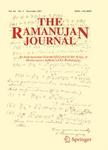版权所有:内蒙古大学图书馆 技术提供:维普资讯• 智图
内蒙古自治区呼和浩特市赛罕区大学西街235号 邮编: 010021

作者机构:Univ Gen Sarmiento CONICET RA-1613 Buenos Aires DF Argentina Univ Gen Sarmiento Inst Desarrollo Humano RA-1613 Buenos Aires DF Argentina Univ Caen CNRS UMR 6072 GREYC F-14032 Caen France
出 版 物:《RAMANUJAN JOURNAL》 (拉马努金杂志)
年 卷 期:2011年第24卷第2期
页 面:183-218页
核心收录:
学科分类:07[理学] 0701[理学-数学] 070101[理学-基础数学]
基 金:post-doc CNRS position at GREYC Laboratory, France [UMR 6072] UNGS 30/3084-PIP 11220090100421 CONICET
主 题:Continued fractions Hausdorff dimension Maps of the interval Euclidean algorithms
摘 要:Numbers whose continued fraction expansion contains only small digits have been extensively studied. In the real case, the Hausdorff dimension sigma (M) of the reals with digits in their continued fraction expansion bounded by M was considered, and estimates of sigma (M) for M - a were provided by Hensley (J. Number Theory 40:336-358, 1992). In the rational case, first studies by Cusick (Mathematika 24:166-172, 1997), Hensley (In: Proc. Int. Conference on Number Theory, Quebec, pp. 371-385, 1987) and Vall,e (J. Number Theory 72:183-235, 1998) considered the case of a fixed bound M when the denominator N tends to a. Later, Hensley (Pac. J. Math. 151(2):237-255, 1991) dealt with the case of a bound M which may depend on the denominator N, and obtained a precise estimate on the cardinality of rational numbers of denominator less than N whose digits (in the continued fraction expansion) are less than M(N), provided the bound M(N) is large enough with respect to N. This paper improves this last result of Hensley towards four directions. First, it considers various continued fraction expansions;second, it deals with various probability settings (and not only the uniform probability);third, it studies the case of all possible sequences M(N), with the only restriction that M(N) is at least equal to a given constant M (0);fourth, it refines the estimates due to Hensley, in the cases that are studied by Hensley. This paper also generalises previous estimates due to Hensley (J. Number Theory 40:336-358, 1992) about the Hausdorff dimension sigma (M) to the case of other continued fraction expansions. The method used in the paper combines techniques from analytic combinatorics and dynamical systems and it is an instance of the Dynamical Analysis paradigm introduced by Vall,e (J. Th,or. Nr. Bordx. 12:531-570, 2000), and refined by Baladi and Vall,e (J. Number Theory 110:331-386, 2005).